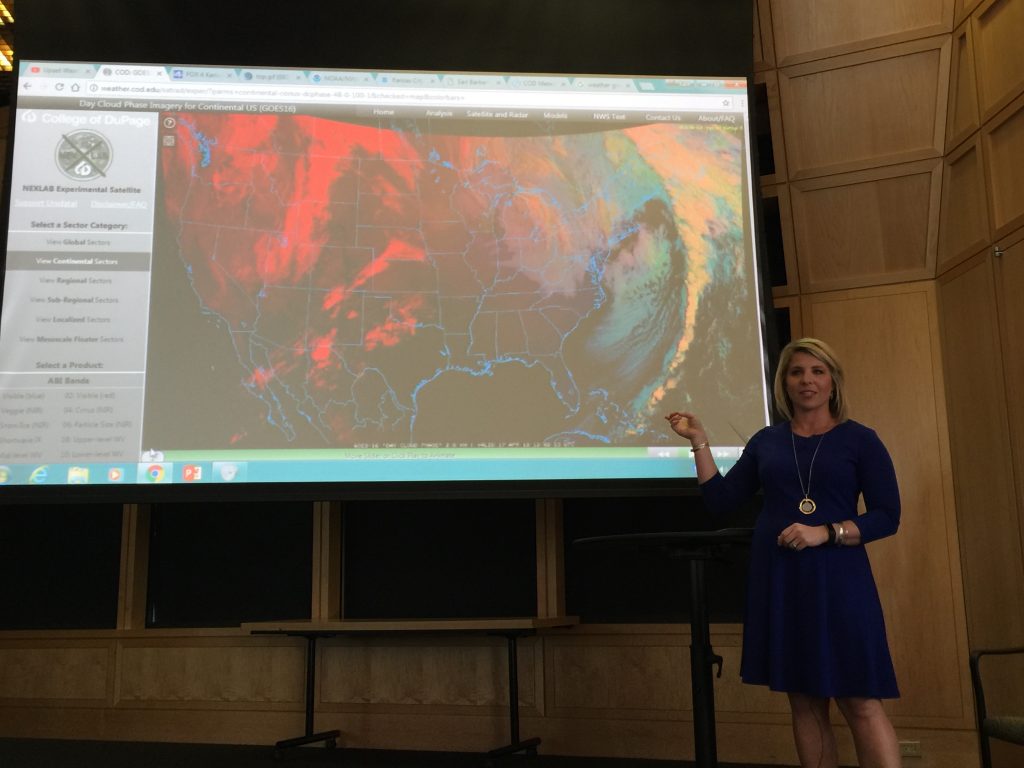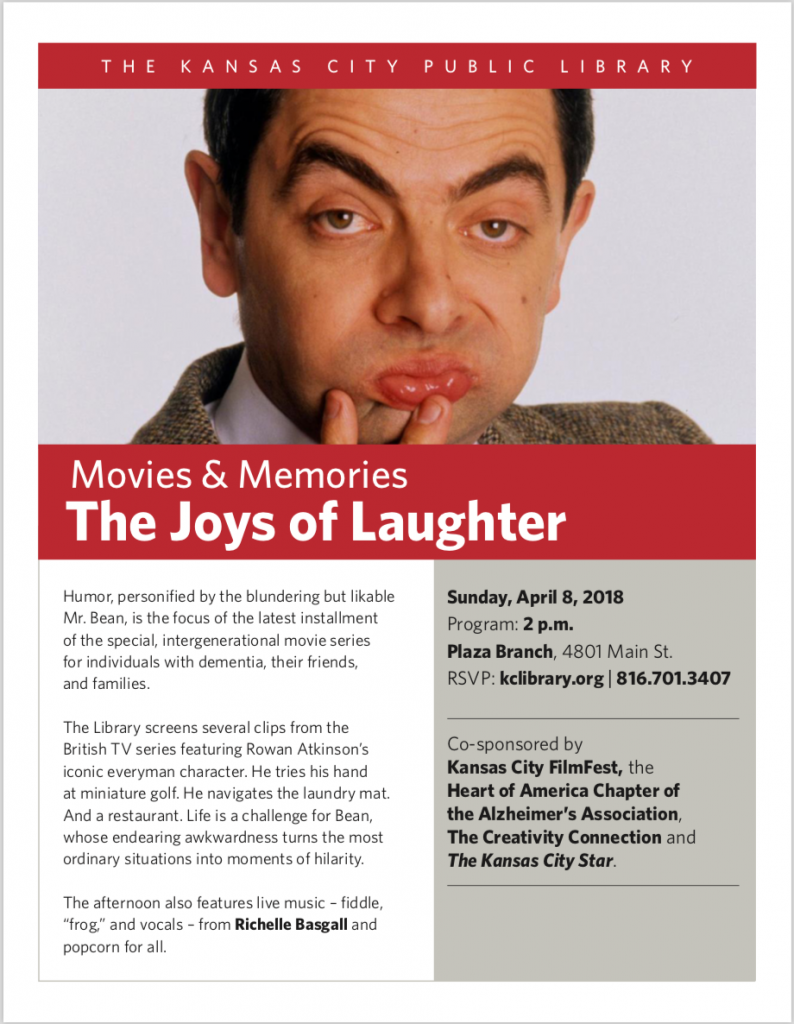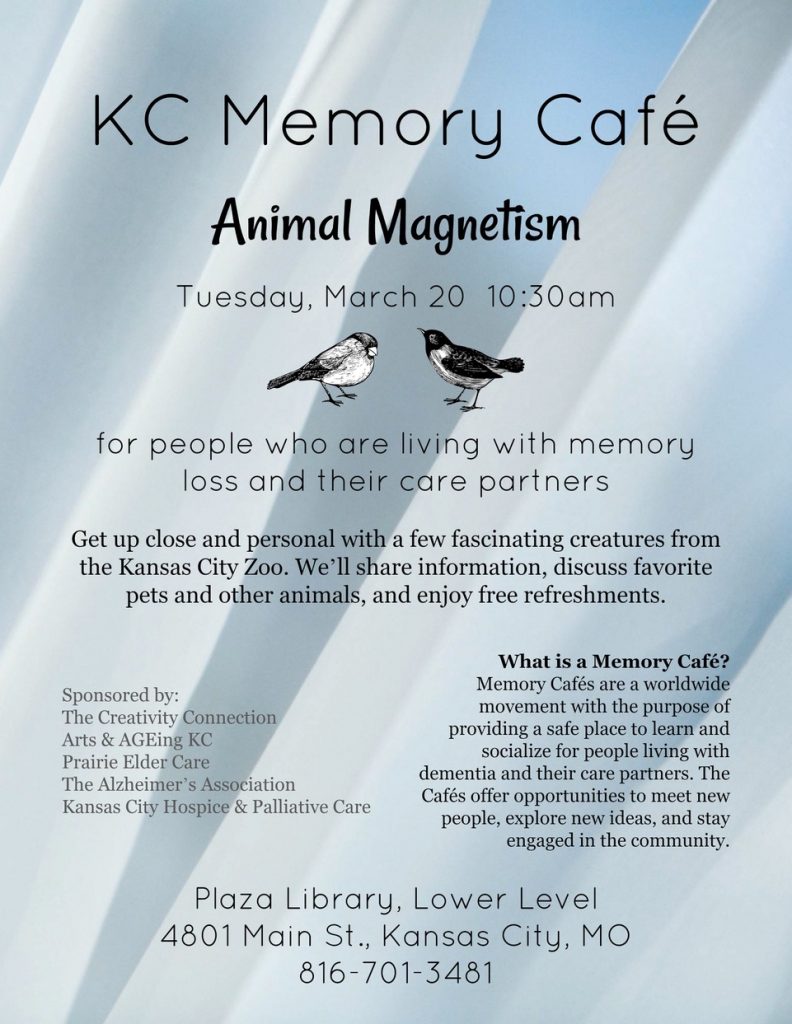Creativity
KC Memory Cafe: Great Weather Information Inspires Great Conversations
 Karli Ritter is a self-described “weather nerd.” When this Fox 4 meteorologist finished her lively talk at April’s KC Memory Cafe, we all had a bit of that “weather nerd” fever in us. We listened intently as Karli described her early morning routine, up at 4:30 a.m., studying the weather maps and data so she could formulate a forecast. She detailed the complexities of being an integral part of a five-hour show: she actually appears on TV 90 times during the Kansas City Fox morning show! Her talk reminded us that great weather information inspires great conversations.
Karli Ritter is a self-described “weather nerd.” When this Fox 4 meteorologist finished her lively talk at April’s KC Memory Cafe, we all had a bit of that “weather nerd” fever in us. We listened intently as Karli described her early morning routine, up at 4:30 a.m., studying the weather maps and data so she could formulate a forecast. She detailed the complexities of being an integral part of a five-hour show: she actually appears on TV 90 times during the Kansas City Fox morning show! Her talk reminded us that great weather information inspires great conversations.
Karli has a love for storms and we were delighted with our “tornado” 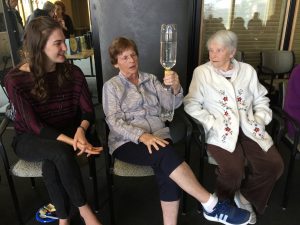 experience, courtesy of the Kansas City Public Library staff. We used a special coupler to link one empty liter bottle with one half full with water. Then we shook and turned it upside down and voila! a little tunnel tornado formed in the water! Each person was fascinated by this experiment. That led us to a conversation about personal weather experiences. Our attendees had gone through hurricanes, earthquakes, dust storms, tornadoes, nor’easter’s and much more.
experience, courtesy of the Kansas City Public Library staff. We used a special coupler to link one empty liter bottle with one half full with water. Then we shook and turned it upside down and voila! a little tunnel tornado formed in the water! Each person was fascinated by this experiment. That led us to a conversation about personal weather experiences. Our attendees had gone through hurricanes, earthquakes, dust storms, tornadoes, nor’easter’s and much more.
Our discussion continued on the way out, with guests describing the varied weather in the Kansas Flint Hills, rainbows they’d seen, family members who loved forecasting the weather, and long hot summers and long cold winters.
To watch our weather wonders, click here.
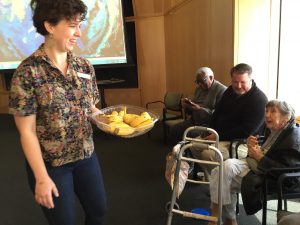
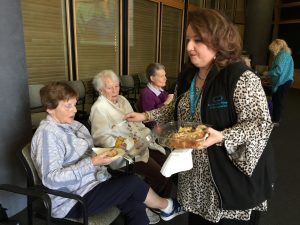 Bringing the weather home.
Bringing the weather home.
To start a weather conversation in your own family or community, use music as a catalyst. Play songs such as: You Are My Sunshine, Stormy Weather, Somewhere Over the Rainbow, Raindrops Keep Falling on My Head, The Sunny Side of the Street, Let It Snow. After each song, ask an open-ended question. “What do you like about snow?” Or,” What seasons do you like most?” Or “Have you ever been in a really big storm?” Or,”What is your favorite kind of weather?”
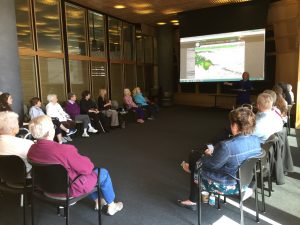
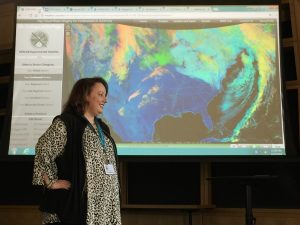 You can also play iconic movie clips that feature weather, such as the joyous tap dancing scene in Singing in the Rain, or the tornado scene in The Wizard of Oz.
You can also play iconic movie clips that feature weather, such as the joyous tap dancing scene in Singing in the Rain, or the tornado scene in The Wizard of Oz.
Dramatic weather photos and pictures can also trigger memories and comments.
Thanks to our Cafe Team and thanks for those who visited.
Our next adventure: May 15, 10:30 to 12:00, Plaza Library
Music to Our Ears: The Kansas City Symphony Brings Us Note-worthy Instruments
You’ve heard them as part of the orchestra. Now you’ll be meeting selected instruments first-hand, as the Symphony’s Margaret Halloin joins us for this delightful interactive session. Enjoy refreshments and interesting conversations as we learn more about the sounds of music.


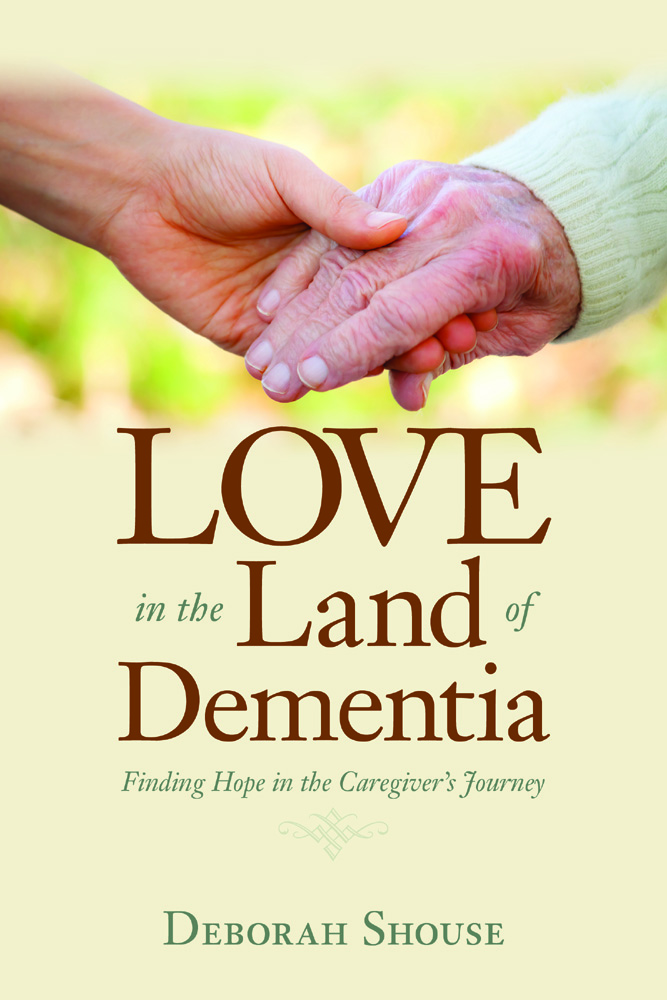
Movies and Memories: Laughter Triumphs Over Weather
It’s a Sunday morning in early April and we were excited about our Movies and Memories laughter program that afternoon at 2:00.
Then, the unthinkable happened. It started to snow, blanketing the daffodils and tulips with just enough flakes to make people want to cozy up at home.
What did we do? Laugh, of course.
Laughter was the theme of our April program and we had excerpts from the inestimable Mr. Bean to anchor our program.
As Emily from the Kansas City Public Library, Plaza Branch, made our popcorn and other library staff readied the technology, we accepted the fact that we might have only our intrepid volunteers in the audience. We all vowed to have a great time anyway.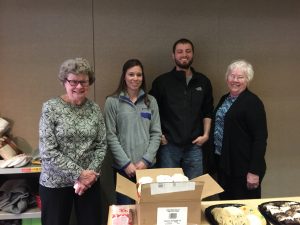
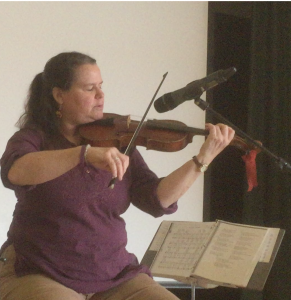 Musician Richelle Basgall regaled us with songs and stories and our guests began to arrive. Soon we had about 30 people who ignored the weather and were ready for fun. And fun we had. One of our volunteers brought us sumptuous cookies and small cakes. The aroma of fresh popcorn warmed us all and we laughed our way through a hilarious clip of Mr. Bean playing miniature golf. Then we passed out jokes, which we laughingly shared with each other. (What kind of sandwiches do astronauts eat: Launch meat! Why did the oil painting get sent to jail? It was framed!)
Musician Richelle Basgall regaled us with songs and stories and our guests began to arrive. Soon we had about 30 people who ignored the weather and were ready for fun. And fun we had. One of our volunteers brought us sumptuous cookies and small cakes. The aroma of fresh popcorn warmed us all and we laughed our way through a hilarious clip of Mr. Bean playing miniature golf. Then we passed out jokes, which we laughingly shared with each other. (What kind of sandwiches do astronauts eat: Launch meat! Why did the oil painting get sent to jail? It was framed!)
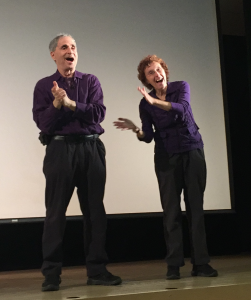 After watching Mr. Bean’s laundromat escapades, we had a laughter yoga session. We didn’t have to worry about traditional physical yoga postures—laughter yoga includes clapping, gestures, playfulness, and breathing. Everyone was a hearty laugher and we were all relaxed and smiling as we watched Mr. Bean’s horror as he tried to cope with raw oysters at a fancy restaurant.
After watching Mr. Bean’s laundromat escapades, we had a laughter yoga session. We didn’t have to worry about traditional physical yoga postures—laughter yoga includes clapping, gestures, playfulness, and breathing. Everyone was a hearty laugher and we were all relaxed and smiling as we watched Mr. Bean’s horror as he tried to cope with raw oysters at a fancy restaurant.
Our ending surprise was a delicious way to take Mr. Bean home— gourmet jelly beans!!
Click here for a short video experience.
 Stay tuned for our next Movies and Memories event in August!
Stay tuned for our next Movies and Memories event in August!
Want to have a movies and memories event right in your own home?
Here are a few tips:
If you’d like to make this an intergenerational experience, select a movie or clips you all might enjoy.
Choose a time of day when the person living with dementia will have good energy.
Get your favorite movie treats ready.
Create times to pause and chat about what you’ve seen.
Print out simple jokes as a great way to spread the laughter.
 If you wish, offer a surprise at the end, either something that reminds you to laugh or smile. And if you like sweets, our jelly beans were a huge hit! With all those flavors, you have a lot to talk about!
If you wish, offer a surprise at the end, either something that reminds you to laugh or smile. And if you like sweets, our jelly beans were a huge hit! With all those flavors, you have a lot to talk about!


The Power of Play in the Dementia Journey
 Josh Rice, a theatre maker and teaching artist, discovered the power of play in the dementia journey when he was still in graduate school. As part of a school project, he partnered with a senior living community on a therapeutic puppetry and improv-based program for people living with dementia.
Josh Rice, a theatre maker and teaching artist, discovered the power of play in the dementia journey when he was still in graduate school. As part of a school project, he partnered with a senior living community on a therapeutic puppetry and improv-based program for people living with dementia.
Together, Josh and the seniors designed and made puppets, and created performances that included songs, personal stories, and comedy. As he worked with the new artists, he noticed people were using their puppets to tell stories. They expressed emotions and they enjoyed the chance to play and have fun. Staff applauded the participants’ short-term memory gains and tactile improvements.
“Plus, we were creating exciting work and performing for people,” Josh says.
Puppetry
One afternoon, a woman who was having a difficult day burst into the puppetry classroom. She was non-verbal but acted out aggressively in a way that could have potentially agitated others. As Josh and the students were rehearsing, she walked in and before she could disrupt the class, Josh made eye contact with her, and gently touched her shoulder. He quietly talked to her and invited her to join in or sit and watch. Within minutes she calmed down.
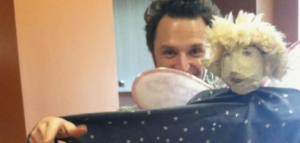 “I put a puppet in her hand and all of a sudden her language came back. It was like a switch had been turned on,” Josh says. This woman filled him with hope and inspired him. “I want people to understand that people who are living with dementia sometimes need us to be patient and keep giving them chances,” he says.
“I put a puppet in her hand and all of a sudden her language came back. It was like a switch had been turned on,” Josh says. This woman filled him with hope and inspired him. “I want people to understand that people who are living with dementia sometimes need us to be patient and keep giving them chances,” he says.
Being in the Moment
Josh knew the potential power of theatrical play and experimented with improv sessions for people living with dementia. The experiment worked.
“For improv, you have to listen and react,” Josh says. “The past or future doesn’t matter; it’s all about the present moment.”
He created a safe, nurturing, and creative atmosphere, offering structured improvisations, and invited his new improv team to play.
“They loved it and it was a thrill to watch them discovering new things and coming up with creative dialogues,” Josh says. “Play is an integral part of our lives and most of us need more of it.”


A Memorable Meeting: KC Memory Cafe
You know what it’s like, creating a program series for the first time. You try to think of everything, knowing that you’ve probably left something out. You hope plenty of people will attend and worry that no one will show up. The weather teases you, threatening snow or rain, thunder or wind. The “what if’s” line up, a mean group of scolders: “What if the elevator breaks? What if the speaker doesn’t show up? What if the snacks don’t arrive? What if the KC Memory Cafe doesn’t work!”
But, as most of us know, worry isn’t really that useful.
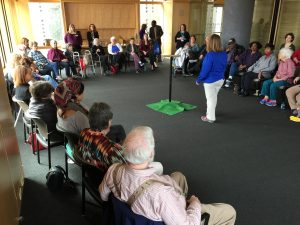 The debut of the KC Memory Cafe was beyond our highest expectations! On March 20, 2018, at 10:30 at the Plaza Library, the educators from the Kansas City Zoo showed up early, riding the elevator down to the lower level with their exotic offerings. The weather was perfect and a lovely group of 40 plus care partners and people living with dementia joined us, delighting in the delicious snacks. And they were even more delighted with the program, all of us laughing at the antics of the cockatoo, leaning forward to see the Vietnamese Tree Frog cozied in his glass aquarium, and petting the chinchilla, with a fluff of fur that felt like a cloud.
The debut of the KC Memory Cafe was beyond our highest expectations! On March 20, 2018, at 10:30 at the Plaza Library, the educators from the Kansas City Zoo showed up early, riding the elevator down to the lower level with their exotic offerings. The weather was perfect and a lovely group of 40 plus care partners and people living with dementia joined us, delighting in the delicious snacks. And they were even more delighted with the program, all of us laughing at the antics of the cockatoo, leaning forward to see the Vietnamese Tree Frog cozied in his glass aquarium, and petting the chinchilla, with a fluff of fur that felt like a cloud.
“I love this animal,” one attendee said, smiling at the blue tongued skink.
“This is the softest fur I’ve ever experienced,” said another, reveling in the chinchilla.
“That bird is so funny,” said another, laughing as the cockatoo bounced up and down, “dancing.”
After learning about the animals, we talked about our own pet memories. It was a wonderful morning and we can’t wait for our next Memory Cafe, on April 17, 2018.
Click here so you can experience the fun of the Cafe.
https://drive.google.com/open? id= 1mU8Iw83lGbhw6FeAVJ3VQ8xhe75qt YYm
 Want to join us on April 17 for our next Cafe? Here’s the scoop!
Want to join us on April 17 for our next Cafe? Here’s the scoop!
Weather Wonders: The Inside Story
Metereologist Karli Ritter Reveals Weather Mysteries 10:30 am on Tuesday, April 17, 2018. Plaza Library Lower Level. Join us for the KC Memory Cafe, a free event dedicated to creating educational and social experiences for people who are living with memory loss and for their care partners.
Our Team — Standing: Emily Cox, April Roy, Carol and Dennis McCurdy. Sitting: Ron Zoglin and Deborah Shouse, Jennifer Walker, Mandy Shoemaker
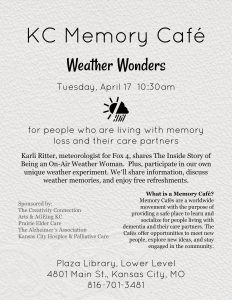


Dementia in the Land of Vietnam
“We are here to see Dr. Nguyen Thanh Binh, head of the Department of Neuroloy and Alzheimer Diseaese,” I tell the guard at the National Geriatric Hospital of Vietnam in Hanoi, showing him my folded paper with her name printed on it.
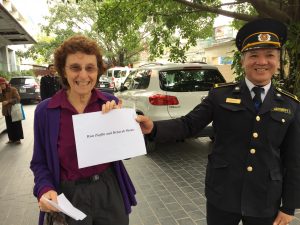 He grins, then points to a full size sheet of paper in the security booth’s window with our names printed on it. We follow him into the hospital and up a flight of stairs. After a short wait, Dr. Binh warmly welcomes us into her office. She has a table ready with chairs and tells us she has invited others from her department to talk to us as well. Another Dr. Nguyen Thanh Binh arrives. Her Phd thesis was on easing the burden for family caregivers. Dr. Ngan Thi Hong Anh, doctor of rehabilitation, joins us. She seeks non-medical solutions for improving quality of life. Nguyen Ngoc Anh, RN, completes our group. She works daily, communicating with and caring for people who are living with dementia.
He grins, then points to a full size sheet of paper in the security booth’s window with our names printed on it. We follow him into the hospital and up a flight of stairs. After a short wait, Dr. Binh warmly welcomes us into her office. She has a table ready with chairs and tells us she has invited others from her department to talk to us as well. Another Dr. Nguyen Thanh Binh arrives. Her Phd thesis was on easing the burden for family caregivers. Dr. Ngan Thi Hong Anh, doctor of rehabilitation, joins us. She seeks non-medical solutions for improving quality of life. Nguyen Ngoc Anh, RN, completes our group. She works daily, communicating with and caring for people who are living with dementia.
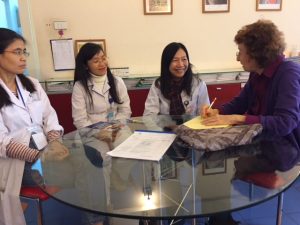 For two years. Dr. Binh and her team have been running a pilot study, inviting people who are living with dementia to attend a three day a week program that focuses on engaging socially, physically, emotionally, and intellectually. They use music therapy techniques, they bake traditional cakes together, and they enjoy various arts and crafts projects. All these therapies offer physical and occupational therapies, as well as vital social interactions. The project has been a huge success, with both family caregivers and people living with dementia enjoying the results. Besides giving the caregivers a much needed respite, families report improved quality of life and and increased abilities in the activities of daily living.
For two years. Dr. Binh and her team have been running a pilot study, inviting people who are living with dementia to attend a three day a week program that focuses on engaging socially, physically, emotionally, and intellectually. They use music therapy techniques, they bake traditional cakes together, and they enjoy various arts and crafts projects. All these therapies offer physical and occupational therapies, as well as vital social interactions. The project has been a huge success, with both family caregivers and people living with dementia enjoying the results. Besides giving the caregivers a much needed respite, families report improved quality of life and and increased abilities in the activities of daily living.
“Symptoms improve,” Dr. Binh reports. “Patients want to keep attending and families have their burdens eased.”
Dr. Binh and her team have extended the program.
 Often people come to the hospital, seeking answers to issues related to memory loss. Many elders live at home with extended families, and their children and grandchildren are frequently confounded by their cognitive impairments and other symptoms of dementia. Dr. Binh and her associates offer education, information, and comfort. They describe the disease and try to help families move beyond their initial feelings of hopelessness. They encourage families to accept and embrace their elder and support him or her in living a meaningful life.
Often people come to the hospital, seeking answers to issues related to memory loss. Many elders live at home with extended families, and their children and grandchildren are frequently confounded by their cognitive impairments and other symptoms of dementia. Dr. Binh and her associates offer education, information, and comfort. They describe the disease and try to help families move beyond their initial feelings of hopelessness. They encourage families to accept and embrace their elder and support him or her in living a meaningful life.
We left our meeting with these remarkable women feeling inspired. They are doing important work and making a difference for the people of Hanoi and Vietnam.


Hooked on Sharing Ideas and Stories that Connect
One of the many things we love about sharing ideas and stories that connect people during the dementia journey—we never know the brilliant, witty, and amazing things our participants will say!
Let me set the scene:
It’s Thursday evening and Ron and I are presenting a program in a church basement. Our audience is a group of dedicated parishioners who serve in the Stephen Ministry, which offers help, hope, and healing. Several are reaching out to people who are living with dementia and want to learn tips for having enriching visits. As we discuss ways to assist people in adapting hobbies and activities, I invite the group to get into dyads and share a favorite hobby and some of the things they enjoy about it.
This is a lively bunch of people and they instantly start talking.Two women on the front row laugh uproariously throughout the exercise. Of course, I am curious. When the exercise is over, I ask, “What are some favorite hobbies?” One of the laughing women points to the other and says, “Would you believe, the first thing out of her mouth? She said, ‘I’m a hooker.’”
There was a bit of a nervous silence.
“A rug hooker,” the woman explains, grinning.
Everyone laughs.
“I love to make hooked rugs and share with them people,” she says.
A man leans forward and looks right at her. “I’m a hooker too,” he says and pauses for dramatic effect. “I like to hook fish. Fishing relaxes me.”
The room lights up with generous laughter. Then we continue the practical matter of adapting hobbies.
So, hopefully you’re now “hooked” on this subject. Here are a few practical tips for adapting hobbies for and with those who are living with dementia.
- Discuss which hobbies are most important.
- List the components of each and learn which parts the person most enjoys.
- Adapt the experience as needed to fit changing abilities and interests.
For gardeners, is it the feel of their hands in the soil?
Is it producing flowers or harvesting vegetables?
Is it having something to take care of?
For those who like quilting, is it making the squares or the finished product? Is it the companionship with other quilters?
Or is it the texture and colors of the fabric?
For those who like cooking, is it the measuring and stirring?
Do they enjoy the aromas and textures of the ingredients?
Is it the joy of preparing something that thrills others?
Or is it the simple pleasure of tasting delicious foods?
With those answers, you can support the aspects of the activity that really resonate and enrich their lives.
Many people who live with dementia deal with social isolation. A big thank you to Nora Ellen Richard and those who are reaching out to stay connected.


A Winning Combination: Children, Exercise, and Music
An orderly group of five-year-olds walk into the dining room at Vernon Manor in Viroqua, Wisconsin. The residents are waiting for them. Each child goes up to an elder and introduces him or her self. Then Ingrid Constalie, AD-BC, CDP, Board Certified Activity Director and Certified Dementia Practitioner, talks to the assemblage about the importance of staying fit. The residents nod sagely: many of them are in their eighties and nineties and they exercise every day. But the days that the kindergartners join them are the best, a winning combination or children, exercise, and music.
The residents love teaching the kids the alphabetic movements to the iconic YMCA song. And the kids are a burst of giggles and wiggles as they fold their arms into wings, strut around, and teach everyone The Chicken Dance.
Ingrid’s focus is creating moments of joy, engagement, and connection.
Her intergenerational activities spark the residents and reduce the stigmas of aging and dementia by educating and informing local children, teens, their teachers, and other members of the community.
“This dancing and exercise exchange is simple, energizing, and very successful,” Ingrid says.
Sing-O at Bingo
Music Bingo offers middle schoolers a chance to work with Ingrid’s elders.
“This is about creating a good experience for your partners,” Ingrid coaches the children in advance. “You are their connection to the world.”
Ingrid plays an opening melody, using songs such as “Happy Trails,” “You Are My Sunshine,” and “Singing In the Rain.” Those who know the title shout it out. Often, partners confer with each other. The children help locate the song title on the bingo card and place a poker chip on each answer. Even people living with advanced dementia enjoy listening to music and being around the children.
Most of the time, the school children are chatty and at ease. But one girl was scared coming into the care community.
“I paired her with Helen, a woman deep into dementia,” Ingrid says. “Within minute, Helen had her arm around the girl and they were both laughing.”
Even children who act up at school are wonderfully behaved during the Bingo experience.
Creating Comparisons and Compassion
Recently, Ingrid orchestrated a project with a high school English class. They interviewed residents and did a comparison and a contrast. For example: “While Clara is getting out of bed with the assistance of staff, I am getting ready for school. While she wheels herself down a long hallway to a dining room, I am eating toast with my sister.”
The teenage journalists asked simple questions, like “What is your morning like?” “How do you spend your afternoon?” “How do you like to dress?”
The students wrote up the results and made booklets. One family was so inspired by the insights in the booklet, they later read parts of it at the woman’s funeral.
Ingrid’s intergenerational connections explore understanding, create empathy, and help create exciting new relationships.


The Ways the Cookies Crumble
Each woman would bring a batch of home-baked cookies, she wrote. We would then get to sample all the cookies and bring a bag of treats home to our families. I adored the idea of getting to bring my teenage daughters such an array of home-baked sweets. I envisioned a room filled with charming baskets of star-shaped sugar cookies, generously topped with red or green frosting. I imagined a jolly basket of Santa cookies and a fragrant ginger-scented array of reindeer cookies. I fantasized about thumbprint cookies, shaped like snowflakes and gooey with jam, and about silky buttery sandies melting in my mouth. And…
Then I realized the implication; these holiday cookies would not only need to be beautiful, creative, and delicious, they would need to be presented in festive and unusual ways. I had never really made anything other than the occasional clumpy chocolate chip, peanut butter, or oatmeal cookie. Why hadn’t my mother been a more glamorous baker, I fretted, as I rummaged in the refrigerator for something to make for dinner. She only made the plainest of cookies—date crumbs, peanut butter, and chocolate chip. As I boiled water for pasta and heated up the jar of marinara sauce, a number floated into my head and I dialed it.
“If I go to this party, will you help me with a recipe and a cute idea for presenting the cookies?” I asked my friend Judith, who was graced with five-star baking abilities.
“Of course,” she said. Judith’s aplomb would fit right in at such a gathering. Briefly, I wondered if she could attend in my place and just deliver my treats to me.
I told my daughters the good news—in several weeks we would have our own private holiday cookie festival. Since our sweets were usually made by some giant corporate entity, they were ultra-excited.
A week later, I received a thick packet in the mail. Judith had selected a number of “easy” recipes for me. I smiled as I looked over the pictures of adorable cookies with a cute holiday twist.
I frowned as I read through the baking instructions; each cookie demanded its own specialized pan, gourmet tool, thermometer, or esoteric ingredient.
As the day of the cookie party neared, I had no recipe, no cookies, no plan, and nothing good to wear.
That night at dinner, I said, “I don’t think I can go to the party.”
“Why not?” Sarah said sharply. She was thirteen and took promises and plans very seriously. Plus, she had a highly sophisticated taste for sweets and was looking forward to expanding her repertoire.
“I can’t just walk in carrying a paltry tray of blobby looking chocolate chip cookies.” My throat constricted and I wished I were a mother who could whip up a butterscotch soufflé from ingredients that just happened to be in my kitchen cabinets.
“Why not?” my older daughter Jessica said. Even during the holiday season, she kept to her black-themed wardrobe. She looked Gothic and serious as she said, “Everyone else will be all silver bells and fancy sprinkles. You will represent the good old- fashioned approach to the holidays; your simplicity will be refreshing.”
I took a breath and considered her words. If worse came to worse, I could always pretend I never saw those cookies before in my life.
That evening, my daughters and I made chocolate chip cookies and put them in a tin lined with aluminum foil. In honor of the season, I unearthed a shiny red bow to top the tin.
Walking into the party was like walking into a fairyland. Christmas lights lined the windows and a sparkling tree spread its branches into the living room. The dining room table looked like the December cover of Gourmet magazine. Stars, hearts, Christmas trees, snowmen, all the icons of the season were glowing with icing and sprinkles.
Some cookies were nestled in hand-made wreathes. Others shone from star-shaped or tree shaped boxes. A miniature set of reindeer surrounded a bejeweled fruitcake. A galaxy of colorful star-shaped cookies decorated a tiered silver-server. I admired each display while looking for a quiet corner where I could tuck in my tin of chocolate chips. I finally settled them between candy cane cookies and gingerbread Santas.
My hostess offered me champagne and the conversation flowed. Then she announced, “It’s time to gather the cookies.” She had a large silver gift sack for each of us and encouraged us to take several of each cookie. As I toured the table, I sneaked a look at my humble confection. What if no one took any? What if I had to bring the whole batch home? What if… The doubts daunted me as I filled my sack with delectables.
“Who made the chocolate chip cookies?” someone asked. The room quieted and my breath quickened. As the silence spread, I finally said, “I did.”
“What an interesting idea,” someone said.
“I never would have thought of it. It’s comforting. These cookies remind me of my mother and home.”
I smiled as I put three Santas in my sack and headed for the reindeer.
That evening my daughters and I had a magnificent holiday feast, consisting of cookies, cookies, and cookies.
“Here’s the strange thing, Mom,” Jessica said, as she leaned back, sated. “Your cookies are really just as good as any of them. Not as cute, but just as delicious.”
“More delicious,” Sarah said.
I smiled, thinking that about my mom’s cookies when I was growing up. Maybe there was something about the plain old recipes offered in the plain old way, so sturdy, so unglamorous, and yet so deliciously like coming home.


My Mom’s New Holiday Tradition: Smiling
**
We roll into the memory care facility’s dining room just as the show is ready to start. The singer, Thelda, kicks off her shoes and presses play on the boom box. Above the cheerful sound track, she sings Jingle Bells. She dances across the room with the remnants of ballroom steps. She stops in front of Mom and sings right to her. She gets on her knees, so she can look into Mom’s eyes, and keeps singing. Mom notices her and smiles a little.
Thelda moves on, singing to each of the patients gathered around, so intent on making a connection that she often forgets the words.
“Is it all right for your Mom to come to Christmas holiday events?” the activity director had asked me, when Mom moved in.
“Yes, I’d like her to go to any activities. She likes the extra energy.”
I think Mom would approve of my decision, even though she has never celebrated Christmas. Growing up, her immigrant mother held on to the Jewish spirit of her home, kneading dough for Friday evening challah, observing each holiday and prayer period in her own way. Some orthodox women followed the religious law that commanded a small piece of the dough be burned as an offering to God. My grandmother was poor; she did not believe in burning good food, regardless of tradition. So she sacrificed a portion of the dough to her youngest daughter, my mother Fran. She created a “bread tail,” leftover dough that she baked, then smeared with butter and sprinkled with sugar . When Mom used to talk about her mother, she always mentioned this special treat.
Even when I was growing up, and we were the only Jewish family in our neighborhood, my mother still did not sing Christmas song. She let the holiday rush by her, like a large train, whooshing past and leaving her behind.
 Now, I am singing Christmas carols to my Mom for the first time and she is smiling. She has moved beyond the place where the religions are different, beyond the place where she wants to separate the dough and make a sacrifice for tradition. Her new tradition is anyone who can make her smile.
Now, I am singing Christmas carols to my Mom for the first time and she is smiling. She has moved beyond the place where the religions are different, beyond the place where she wants to separate the dough and make a sacrifice for tradition. Her new tradition is anyone who can make her smile.
With each song, from White Christmas, to Silver Bells, to Frosty the Snowman, Thelda moves back to Mom, tapping her, acting sillier and sillier. Each time, Mom lifts her head and widens her mouth for a second.
For her finale, Thelda puts on a big red nose and sings Rudolph. When she dances in front of Mom with that scarlet nose, Mom laughs, her face a miracle in pure enjoyment. I laugh too, so delighted to see Mom engaged and absorbed.
Two weeks from now, I will bring a menorah and candles into my mother’s room. My father and I will have a short Chanukah ceremony with Mom. She will pick at the shiny paper covering the Chanukah gelt (chocolate candy disguised as money). She will slump over in her chair. But she will come back to life when she sees me, her only daughter, wearing a big red nose as I light the menorah.Here’s to a meaningful and fun holiday season.
I look forward to connecting with you when I resume blogging in early January.


Six Secrets of Dementia Inclusive Holiday Cooking
I named my brother Dan, our head chef, first. Then I included the support team—myself, my mom, my daughters and nephews.
“Did I help?” Mom whispered as I passed her the mashed potatoes.
“You sure did,” I told her. ”You mashed the potatoes, put the marshmallows on the sweet potato casserole, and mixed the fruit salad.”
“That’s good,” she said. “I like to help.”
Our desire to help and contribute to seasonal celebrations doesn’t end with a diagnosis of dementia. It’s lovely to linger in the kitchen together, preparing food for the holidays. It’s even lovelier when you can adapt and enjoy dementia inclusive holiday cooking so that people of varying abilities can participate.
Rebecca Katz, author of The Healthy Mind Cookbook, sees food as a great equalizer, something anyone can enjoy regardless of abilities. Fixing a delicacy for someone offers a tangible and delicious way to give back.
Here are six secrets of iementia Inclusive holiday cooking.
- Leaf through a favorite family cookbook or recipe box and use the pictures and recipes as a catalyst for conversation. Ask open-ended questions, such as, ”What does that brownie recipe make you think of?” “What do you like about the holiday season?”
- Chose a time of day when you’re both rested.
- Create a comfortable kitchen environment, by playing familiar seasonal songs you can both hum or sing along to. Reduce extraneous noise and distractions, such as a television in the background.
- If you wish, take photos during the experience. That way, you can relive the adventure and share with family and friends.
- Indulge in instant gratification, if possible, by sampling your work when the cooking is complete.
- Even if the person living with dementia can’t help prepare food, he can still enjoy sitting in on the action and the conversation.
Whether you’re stirring a pot of orzo or dropping mint leaves into cool water, enjoy your time of creation and connection in the kitchen.
A longer version of this piece originally appeared on Joan Lunden’s excellent website: Enjoy Dementia Inclusive Holiday Cooking. Thanks to Sue Fitzsimmons, MS, ARNP, Judith Fertig, author of The Memory of Lemon, Kate Pierce, LMSW, Alzheimer’s Association Greater Michigan Chapter, and Rebecca Katz, author of The Healthy Mind Cookbook
Deborah Shouse is the author of Connecting in the Land of Dementia: Creative Activities to Explore Together and Love in the Land of Dementia: Finding Hope in the Caregiver’s Journey.
